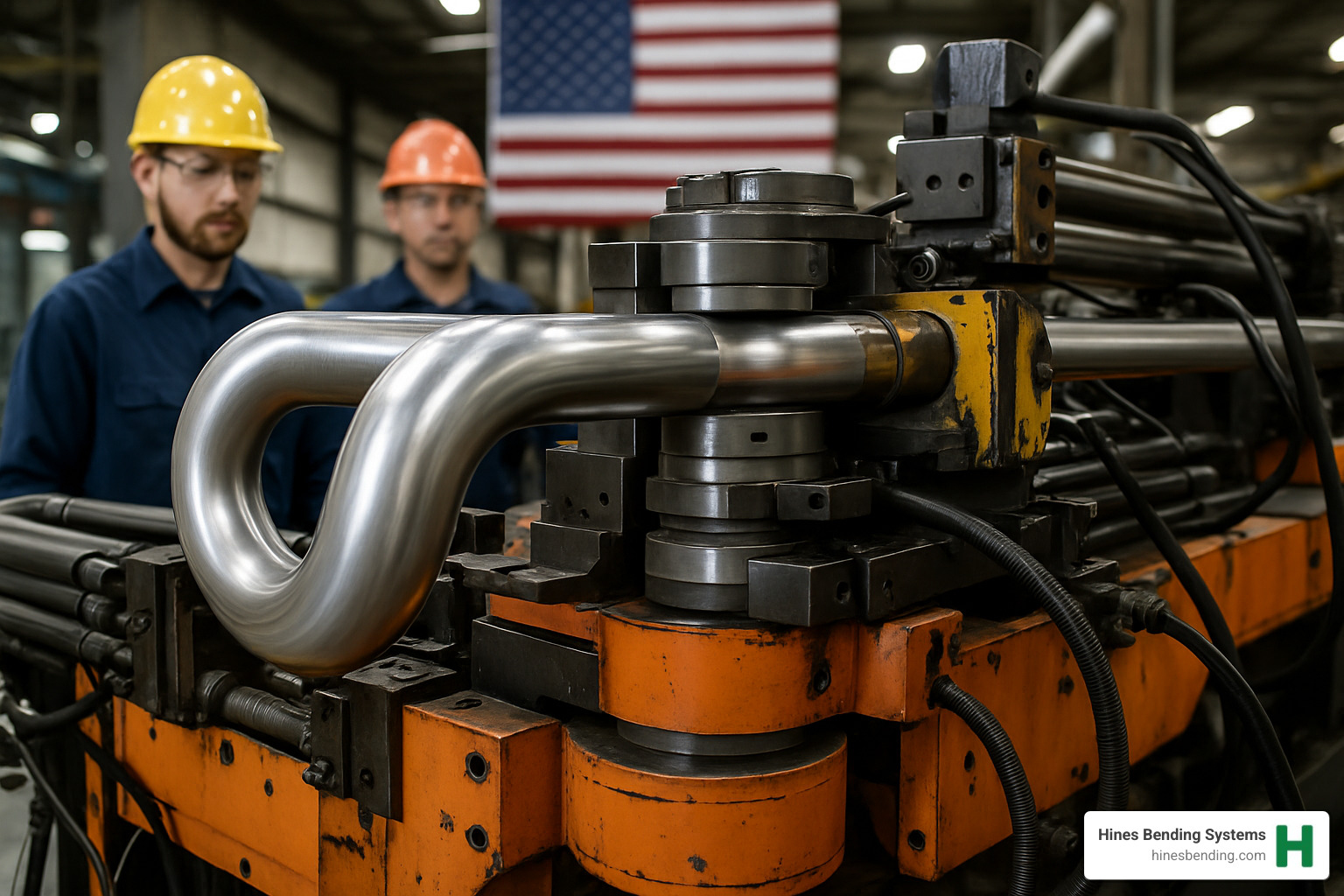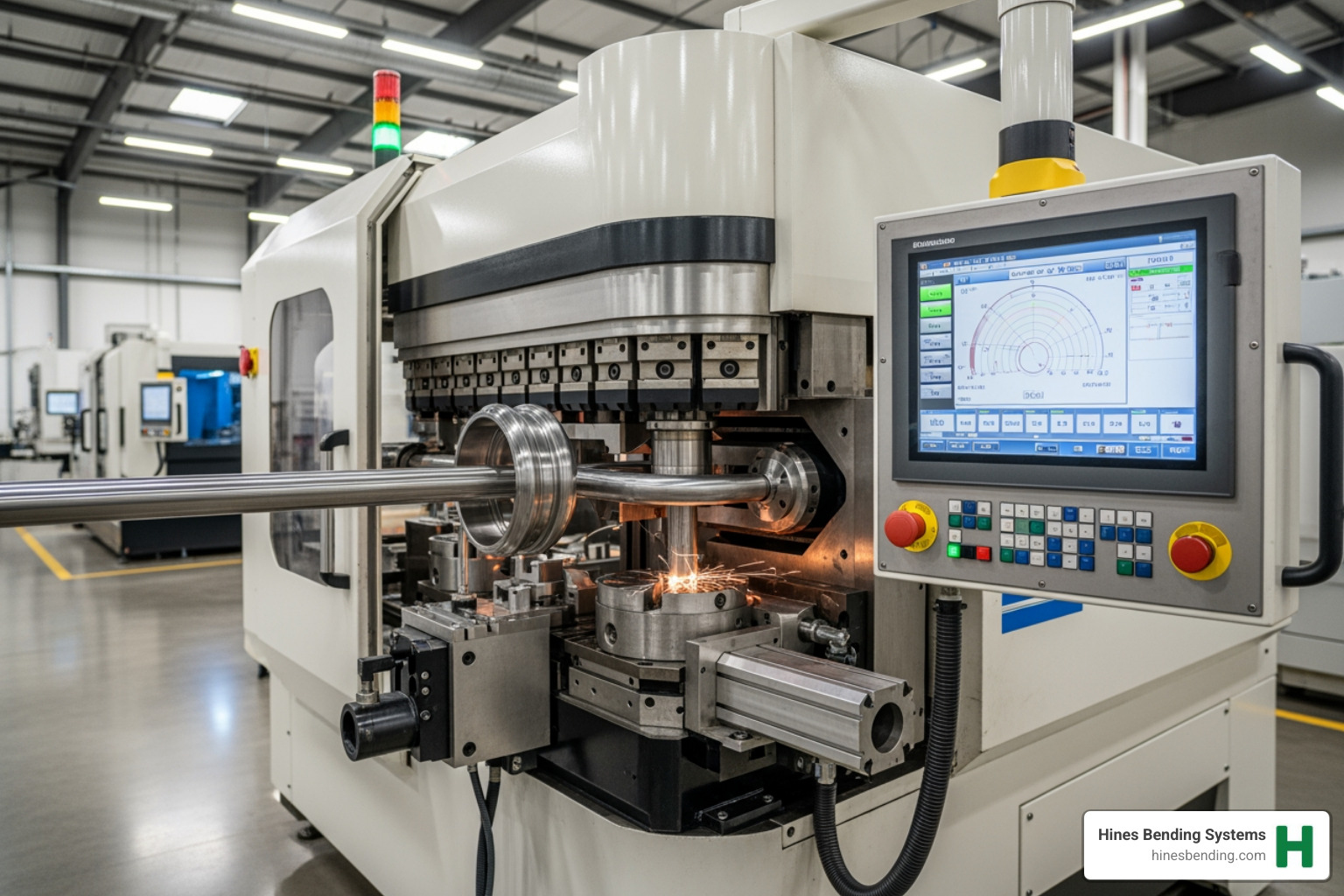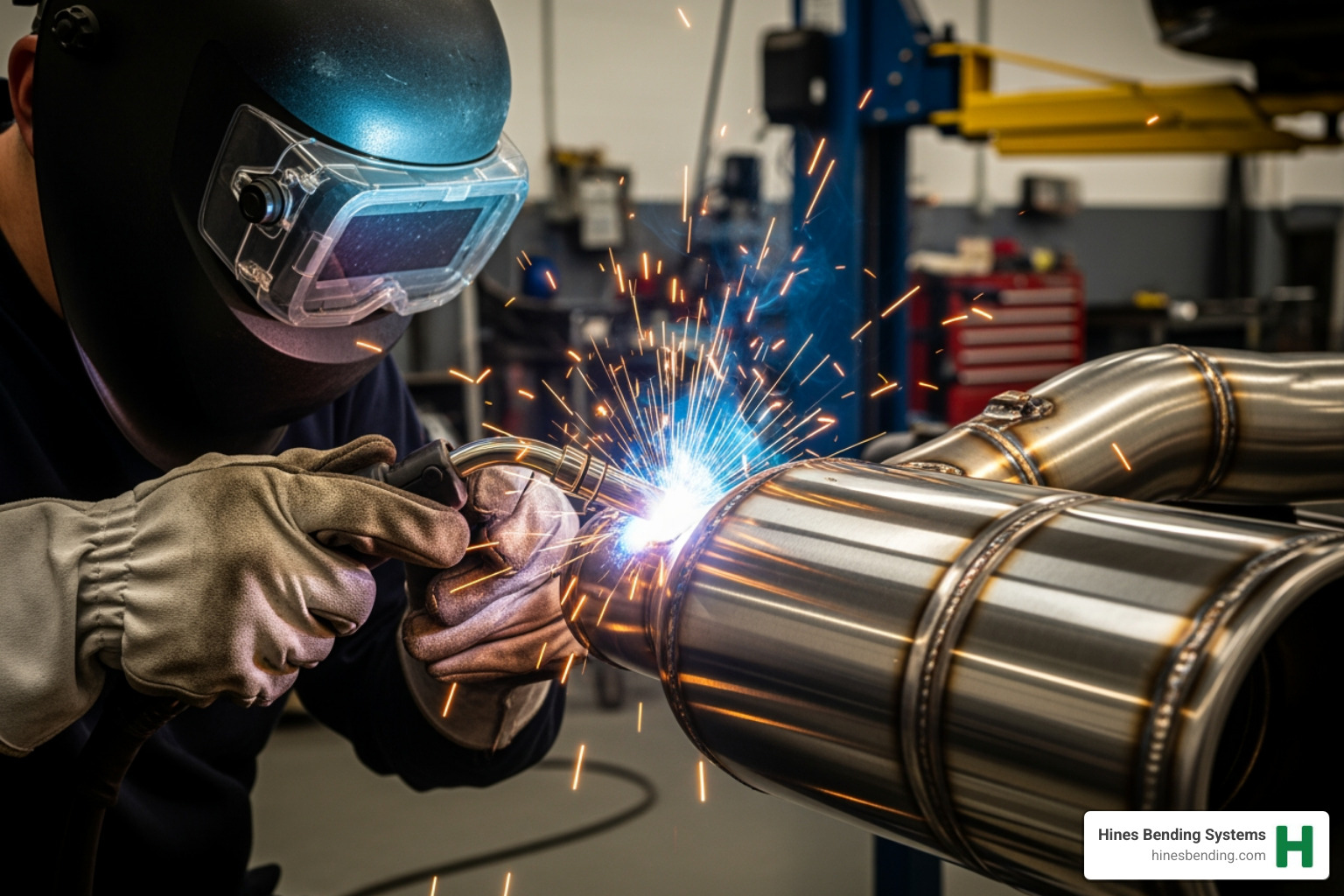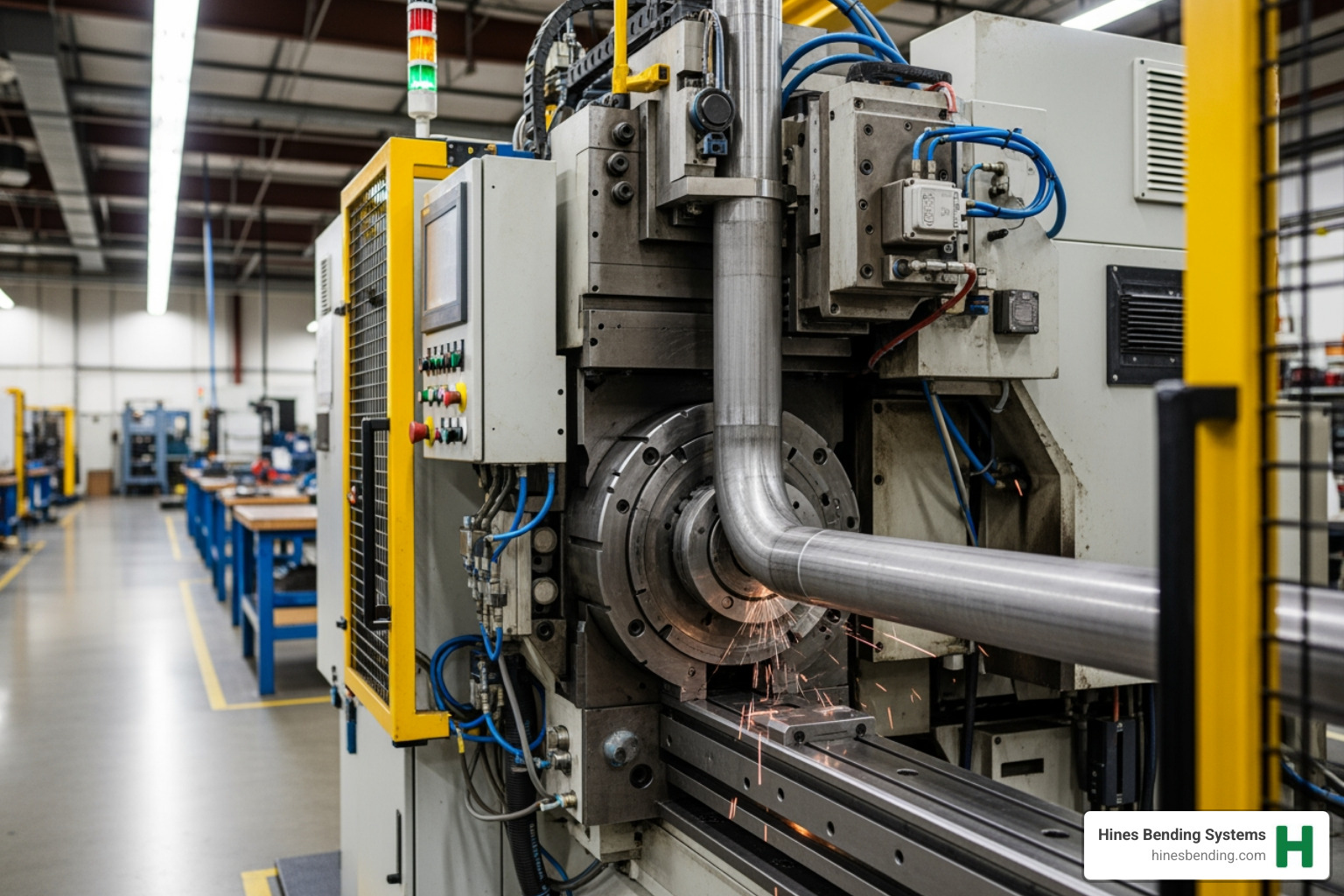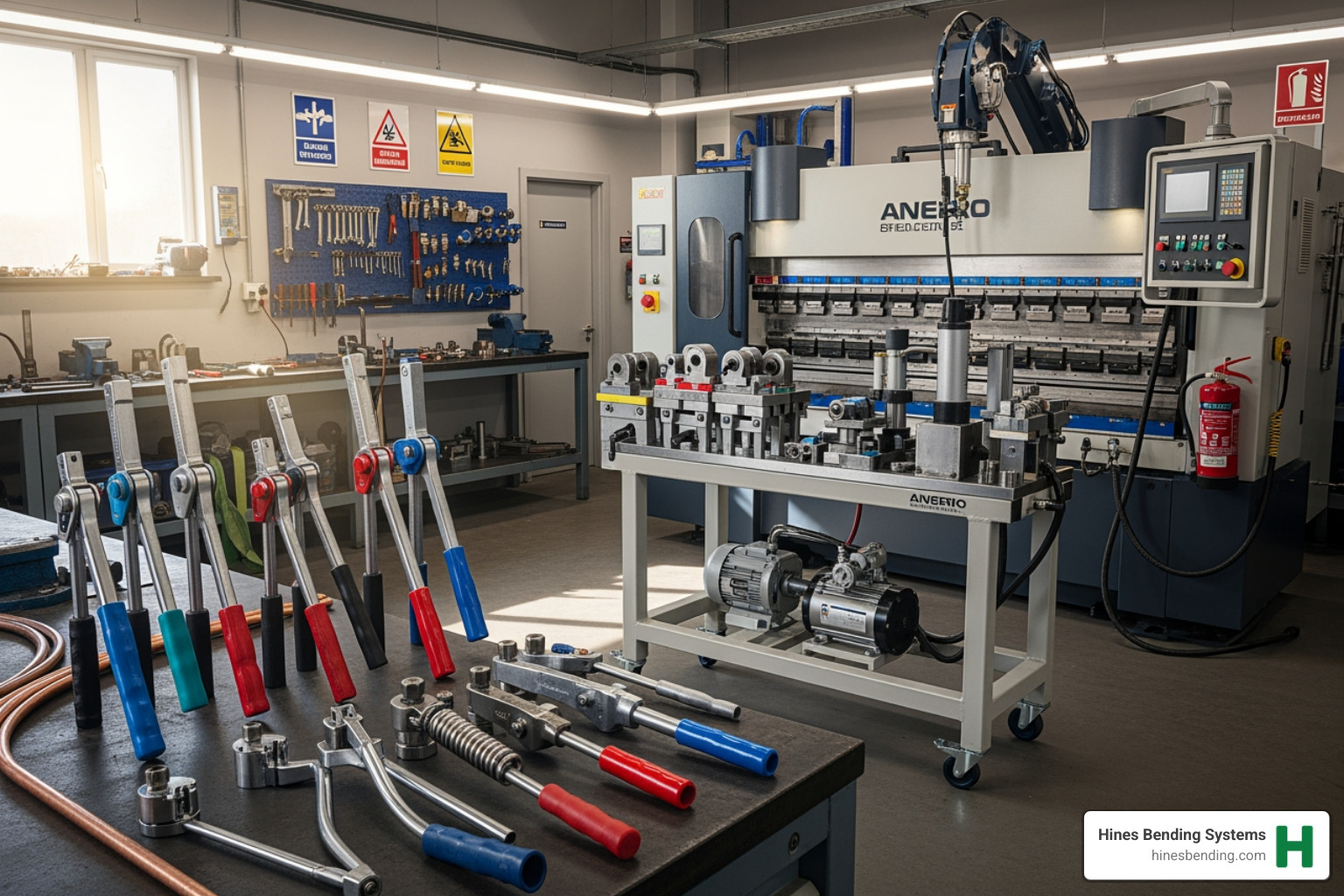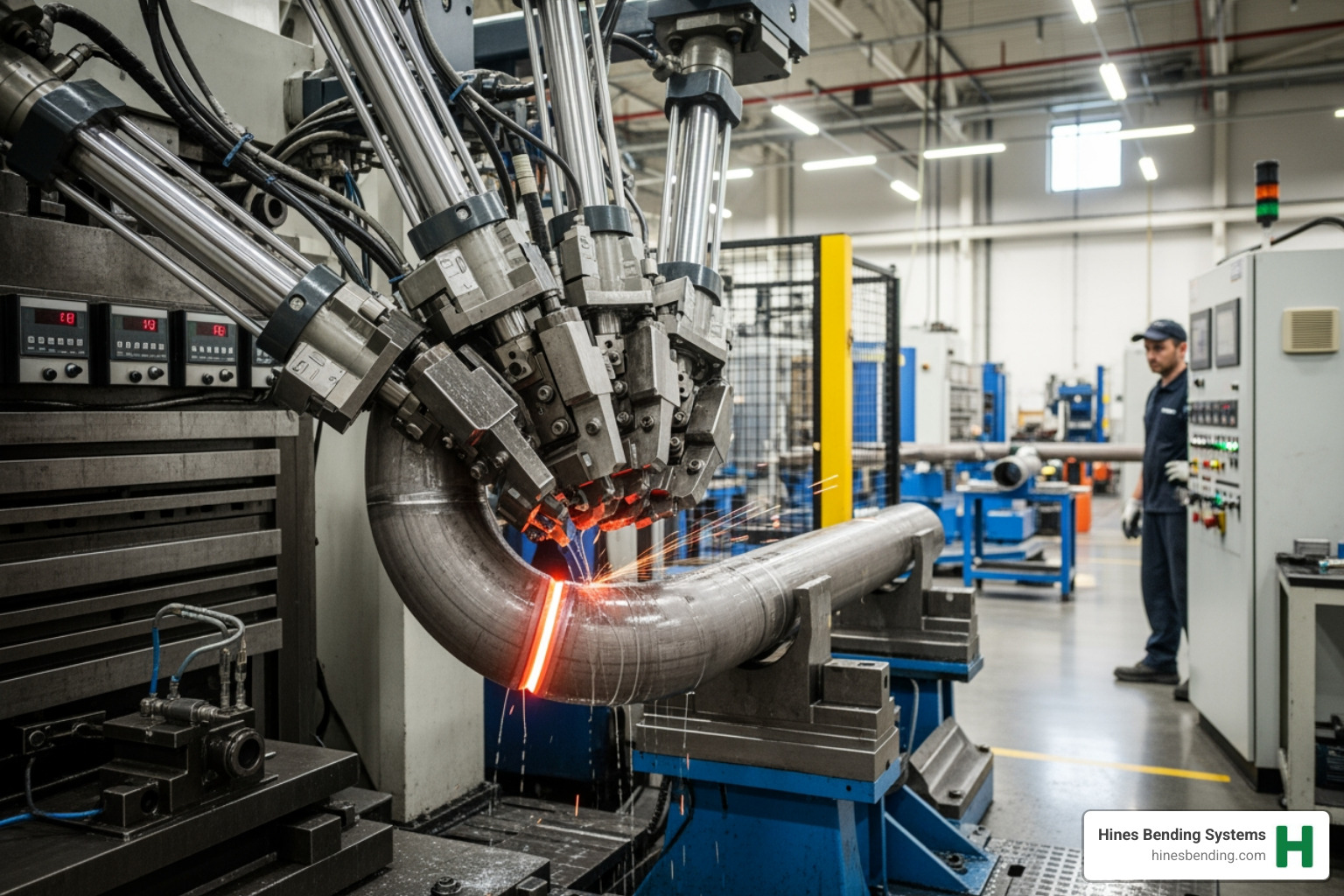The Evolution of Precision: How Pipe Bending Technology Transforms Industries
Ever watched a skilled craftsperson transform a straight metal pipe into a perfectly curved component? There’s something almost magical about it. Pipe bending technology has come a long way from those artisanal roots, evolving into a sophisticated science that powers industries worldwide.
I remember my first visit to a modern bending facility—the contrast between old manual benders gathering dust in the corner and the gleaming computer-controlled systems was striking. What once required skilled hands making educated guesses has transformed into a precise digital science with repeatable, reliable results.
Since the 1970s, we’ve witnessed an incredible journey from simple mechanical processes to sophisticated systems combining servo-electric drives, advanced simulation software, and digital measurement. This evolution has enabled manufacturers to achieve tighter radii and maintain consistent wall thickness—all while reducing waste and production time.
At Hines Bending Systems, we’ve been at the forefront of this change, developing solutions that have revolutionized everything from aerospace hydraulic lines to architectural facades. When NASA needs precision-bent components for applications where failure isn’t an option, they turn to our expertise.
If you’re evaluating bending solutions for your operation, understanding the technology landscape is crucial:
| Key Aspects of Pipe Bending Technology | Description |
|---|---|
| Major Methods | Rotary draw, mandrel, roll, ram, induction, compression, stretch bending |
| Common Applications | Aerospace, oil & gas, automotive, construction, power generation |
| Key Considerations | Material type, wall thickness, bend radius, diameter |
| Industry Leaders | Hines Bending Systems (#1 worldwide manufacturer) |
The versatility of modern bending is remarkable. Today’s solutions handle wall thicknesses from paper-thin 0.5mm to massive 100mm and diameters spanning tiny 4mm tubes to enormous 1524mm pipes. Each application presents unique challenges that require both cutting-edge technology and deep expertise.
“The job is not complete until we achieve your requirements in accuracy and repeatability.” – A standard we’ve upheld at Hines Bending Systems for decades
What truly sets industry leaders apart isn’t just the machinery—it’s the ability to combine technology with decades of hands-on experience, providing custom solutions that address the specific challenges of each application.

Want to explore pipe bending technology further? Check out these resources:
– Custom tube bending
– Bending machines for sale
– Precision pipe bending
Pipe Bending Technology: From Manual Art to Digital Science
The story of pipe bending technology is a remarkable journey from hands-on craftsmanship to sophisticated digital precision. I’ve always been fascinated by how this industry transformed from skilled workers using simple tools and gut instinct into a high-tech field driven by computers and advanced physics.
Back in the early days, pipe bending was a manual affair. Craftsmen would use press bending techniques, essentially forcing pipes against dies to create rather basic bends. The results? Often inconsistent, with limited possibilities for complex shapes. You might say it was more art than science.
The mid-20th century brought the first real game-changer with hydraulic systems. These provided more controlled force, but still heavily relied on the operator’s skill and experience—something that took years to develop.
“Through a winning combination of persistence, innovation, and good old-fashioned hard work, advanced bending technologies have established themselves as industry leaders,” notes one historical account. This spirit of innovation is exactly what has driven Hines Bending Systems to become the world leader in bending technology over decades of dedicated improvement.
The true revolution arrived in the 1970s and 1980s with Computer Numerical Control (CNC). For the first time, bending parameters could be precisely programmed, stored, and duplicated with consistent results. This breakthrough reduced reliance on operator skill and opened doors to complex bending configurations that were previously impossible.
Today’s bending landscape still maintains the fundamental distinction between cold and hot bending. Cold bending, performed at room temperature, excels with thinner-walled materials and smaller diameters. Hot bending—particularly induction bending—enables the forming of thick-walled, large-diameter pipes that would otherwise stubbornly resist deformation.

Legacy Lessons for Pipe Bending Technology
Even as we accept digital advancements, the foundational principles established by early pipe bending pioneers remain incredibly relevant. The first mechanical tube benders from the early 20th century established core concepts that still guide our work today.
Press bending, primitive as it seems now, taught the industry about material spring-back—that frustrating tendency of metal to partially return to its original shape after bending. This early method forced engineers to understand material properties at a fundamental level.
When rotary draw bending emerged in the mid-20th century, it introduced the crucial concept of controlling material flow during the bending process—a principle that remains at the heart of modern CNC bending. As one veteran bender at Hines once told me, “Understanding where the metal wants to go is just as important as knowing where you want it to end up.”
The first CNC benders of the 1980s, while basic by today’s standards, demonstrated the transformative power of precise, repeatable control. These machines established the programming approaches that would evolve into today’s sophisticated simulation and control software.
At Hines Bending Systems, we’ve carefully preserved this historical knowledge while continuously pushing technology forward. Our engineers draw on decades of accumulated expertise to solve complex bending challenges that would have seemed like science fiction just one generation ago.
Hot-vs-Cold—Why the Distinction Still Matters
The fundamental division between hot and cold bending processes remains as relevant today as ever, with each approach offering distinct advantages for specific applications.
Cold bending, performed at ambient temperature, continues to be the most widely used method for most applications. It’s faster, more energy-efficient, and perfect for materials with good ductility at room temperature. Modern cold bending machines from Hines Bending Systems can achieve remarkably tight radii while maintaining wall thickness and cross-sectional geometry—something that amazes even veteran engineers.
“Cold bending with pipe rolling allows precise control of tension, depending on the bend radius and thinning of the outer walls,” explains one of our technical documents. This control is absolutely crucial for maintaining pipe integrity during the bending process.
Hot bending, particularly induction bending, has evolved dramatically with technological advances. Modern induction benders precisely heat only the bend zone to temperatures between 800°F and 2200°F, making the material temporarily malleable without affecting the entire pipe. This localized heating allows for the bending of extremely thick-walled pipes and tubes that would otherwise resist deformation or collapse.
The material itself also influences whether to go hot or cold. While carbon steel can be bent using either method depending on dimensions, materials like high-density polyethylene (HDPE) require specialized approaches. HDPE pipes typically need controlled heating to achieve the thermoplastic state necessary for deformation without damage.
Induction coil technology has seen remarkable advances, with modern systems providing precise temperature control and energy efficiency. Hines Bending Systems’ induction benders represent the cutting edge of this technology, offering best control and repeatability for even the most demanding applications.
Smart Machines & Industry 4.0 Bending
Remember when bending a pipe meant muscling it around a form and hoping for the best? Those days are long gone. Today’s pipe bending technology has acceptd the digital revolution, creating smart machines that think almost as much as they bend.
Modern bending systems have become the brainy athletes of the manufacturing world – powerful, precise, and surprisingly intelligent. At Hines Bending Systems, we’ve witnessed this change firsthand, helping drive innovations that have turned pipe bending from a physical art into a digital science.
“My grandfather used to say he could feel when a bend was right,” a longtime Hines customer once told me. “Today, our machines can measure what he felt – and repeat it perfectly thousands of times.”
The heart of this revolution is advanced CNC control systems that do far more than follow programmed instructions. They actively adapt to material variations, compensate for springback, and adjust on the fly when conditions change. These systems create a continuous feedback loop that ensures every bend meets specifications, regardless of material inconsistencies or environmental factors.
Servo-electric drives have largely replaced traditional hydraulic systems in our precision benders, offering lightning-fast response times and incredible precision. Unlike hydraulic systems that can be affected by fluid temperature and pressure variations, servo-electric systems provide consistent performance and require significantly less maintenance. They’re also more energy-efficient, reducing operating costs while improving results.
One of the most exciting developments has been dual-stack technology, which allows a single machine to perform multiple bending operations without repositioning the workpiece. This dramatically reduces handling time and improves accuracy by eliminating the variables introduced when a part is removed and reloaded.

Perhaps the most transformative technology has been simulation software that creates virtual models of the entire bending process. Before a single piece of metal is touched, our engineers can visualize exactly how it will flow during bending, identifying potential issues like wall thinning or wrinkling. This virtual approach eliminates costly trial-and-error, reduces material waste, and speeds up production.
Want to see these technologies in action? Check out our CNC Tube Bender page for detailed information on our latest offerings.
CNC Revolution in Pipe Bending Technology
The evolution of CNC technology has fundamentally transformed how we approach pipe bending technology at Hines Bending Systems. Today’s smart benders don’t just follow instructions – they actively participate in the bending process.
Modern CNC benders are fitted with an array of IoT sensors that act like a nervous system, constantly monitoring every aspect of the bending operation. Force sensors detect the slightest resistance changes in the material. Position encoders track movement with sub-millimeter precision. Temperature sensors monitor both the machine and material conditions to ensure optimal performance.
All this sensor data feeds into sophisticated adaptive control systems that make real-time adjustments throughout the bending cycle. If a section of pipe shows unexpected resistance, the system will automatically adjust pressure. If material springback is greater than anticipated, the machine compensates immediately. These micro-adjustments happen continuously, creating bends that meet specifications regardless of material variations.
“The first time I saw our new Hines CNC bender compensate automatically for a material inconsistency, I knew we were dealing with something special,” shared one production manager. “It solved a problem before I even realized we had one.”
The integration of these smart benders with broader manufacturing execution systems has created seamless digital workflows. CAD designs flow directly to the shop floor without manual interpretation, eliminating potential errors and dramatically reducing setup time. Production data flows back to management systems, providing real-time visibility into operations.
Of course, even the smartest machines need skilled operators. That’s why we put such emphasis on comprehensive Tube and Pipe Bender Training. Our training programs ensure your team can leverage every capability of these sophisticated systems, maximizing your return on investment while producing consistently excellent results.
Induction, Stretch & Robotic Cells—Where Automation Shines
Some bending challenges demand specialized approaches, and this is where automation truly demonstrates its value. At Hines Bending Systems, we’ve pioneered automated solutions for the most demanding bending applications.
Induction bending represents one of our most sophisticated technologies. By precisely heating only the bend zone using electromagnetic induction, we can form large-diameter, thick-walled pipes that would be impossible to bend using conventional methods. Our automated induction systems maintain perfect control over heating zone, temperature progression, and bending force, creating consistent results even with massive pipes.
“We had tried everything to bend those 36-inch diameter pipes,” recalled one oil industry client. “Hines’ automated induction system handled them like they were garden hoses.” Learn more about our capabilities as an Induction Bending Company.
For applications requiring extremely long bends with minimal wall thinning, our automated stretch bending systems offer best capabilities. These specialized machines maintain constant tension throughout the workpiece during bending, preventing wrinkles while preserving wall thickness. Our systems can handle tubes up to 13 meters in length, making them ideal for architectural applications and transportation components.
The ultimate expression of bending automation is found in our fully robotic bending cells. These integrated systems combine multiple bending technologies with robotic material handling to create autonomous production lines. Raw material enters one end, and finished components emerge from the other, with robots handling all the intermediate steps. These cells can operate 24/7 with minimal supervision, dramatically increasing productivity while maintaining perfect consistency.
One fascinating application has been in electric vehicle manufacturing, where our robotic cells bend complex busbar configurations for battery systems. These critical components must be formed with absolute precision to ensure proper electrical performance and thermal management. Our automated systems deliver this precision consistently, bend after bend.
When considering your next bending project, Hines Bending Systems offers not just machines, but complete solutions custom to your specific requirements. No other company has installed more bending machines worldwide or developed more custom solutions for challenging applications.
Material & Geometry: Designing for the Perfect Bend
The successful application of pipe bending technology begins with a thorough understanding of material properties and geometric constraints. I’ve seen how different materials present unique challenges when they meet the bending machine—each with its own personality and quirks.
Steel remains the workhorse of the bending world, but even this common material comes with variations that significantly impact your results. Low-carbon steels bend with relative ease, almost like they’re cooperating with you. High-carbon or alloy steels? They’re the stubborn ones, often requiring some heat before they’ll agree to take a tight radius without cracking.
Stainless steel presents its own set of challenges. While it offers excellent corrosion resistance (perfect for food processing and pharmaceutical applications), its work-hardening properties mean it demands greater force and more precise control during bending. As one of our engineers at Hines Bending Systems likes to say, “Stainless steel remembers everything you do to it—and sometimes holds a grudge.”
Copper and aluminum are the more compliant materials in the bending family. They’ll typically achieve tighter bend radii with less force, but this compliance comes with a catch—they’re more prone to wrinkling or collapse without proper support. It’s like trying to fold a soft blanket versus a stiff sheet; the former needs more guidance to maintain its shape.
HDPE and other polymers are a different animal entirely. These materials often need controlled heating to reach that sweet spot where they become temporarily pliable without sustaining damage. At Hines Bending Systems, we’ve perfected the art of heating these materials just enough—not too little, not too much.
The geometry of the bend itself is equally critical to your success. Bend radius is typically expressed as a multiple of the pipe’s outer diameter (OD)—commonly referred to as 1D, 2D, 3D, etc. Think of it this way: a 2D bend radius for a 3-inch pipe means the centerline radius of the bend is 6 inches. The tighter the radius (smaller multiples), the greater the challenge in maintaining wall thickness and cross-sectional shape.
| Material | Minimum Cold Bend Radius | Minimum Induction Bend Radius | Wall Thinning | Applications |
|---|---|---|---|---|
| Carbon Steel | 2-3D | 1-1.5D | 10-15% | General construction, oil & gas |
| Stainless Steel | 2.5-3.5D | 1.5-2D | 12-18% | Food processing, chemical, pharma |
| Copper | 1.5-2D | Rarely used | 8-12% | HVAC, plumbing |
| HDPE | 20-30D | Heat bending: 10-15D | Minimal | Water supply, chemical transport |
At Hines Bending Systems, our deep expertise across all material types ensures we can recommend the optimal bending solution for any application. We’ve spent decades learning the unique “personalities” of different materials, allowing us to balance their properties with your geometric requirements to achieve that perfect bend every time.

Mandrel Choice & Wall-Thinning Control
Selecting the right mandrel is like choosing the perfect assistant for your bending operation—one who knows exactly when to support and when to give way. These internal supports, inserted into pipes during bending, prevent collapse and control wall thinning, particularly for thin-walled materials and tight-radius bends.
“Mandrel bending is the ideal method for bending tubes in very tight radii,” notes an industry source, a principle that we at Hines Bending Systems have refined through decades of hands-on innovation. Our Mandrel Bending Machine solutions represent the pinnacle of this technology—the result of countless hours solving real-world bending challenges.
The mandrel family offers options for every bending scenario. The plug mandrel—the simplest member of the family—provides basic support but limited control over wall thinning. Think of it as training wheels for your bending operation. Form mandrels offer improved support but still allow some deformation, while ball mandrels, consisting of articulated segments, provide superior support throughout the bend while still allowing extraction after bending—like a spinal column that bends with the pipe and then straightens for removal.
For the most demanding applications, our advanced flexible mandrels use innovative designs to provide optimal support. “Using a mandrel with flexible support when bending tubes up to Ø159 mm prevents wrinkling,” explains a technical document—a capability that Hines Bending Systems has perfected through years of focused development.
Wrinkle mitigation remains a primary concern in mandrel selection. Without proper internal support, compression forces on the inside radius of a bend can cause material to buckle, creating wrinkles that compromise both aesthetics and structural integrity. I like to explain it to clients this way: imagine trying to bend a drinking straw—without something inside, it kinks. The proper mandrel, correctly positioned, prevents this buckling while allowing controlled material flow.
Mandrel positioning is a science unto itself. The optimal position is typically at two-thirds between the line of tangency and the limiting intersection—a placement derived from the Pythagorean theorem. This precise positioning ensures optimal support without impeding material flow, like knowing exactly where to place your hand to guide a child learning to ride a bike.
For those truly challenging applications—ultra-thin-walled tubes with tight bend radii that would make other manufacturers turn away—we offer specialized solutions like the two-way lamellar mandrel or multidirectional dome-sheet mandrel, providing unprecedented support and control that simply isn’t available elsewhere.
Diameter, CLR & Springback—Numbers That Matter
In the precision world of pipe bending technology, understanding the relationship between pipe diameter, centerline radius (CLR), and material springback isn’t just technical jargon—it’s the difference between success and failure in your bending projects.
The centerline radius (CLR) of a bend tells you how sharp or gradual your curve will be, typically expressed as a multiple of the pipe’s nominal diameter. We in the industry refer to these as 1½D, 3D, 5D, and so on. Here’s a simple way to think about it: if you’re bending a 4-inch pipe with a centerline radius of 6 inches, that’s a 1½D bend. The same pipe with a 12-inch radius? That’s a 3D bend.
These classifications aren’t just arbitrary numbers—they have real-world implications. A 1½D centerline radius bend is directly interchangeable with standard long-radius butt weld elbows, making it the go-to choice for piping systems where components might need future replacement or modification. It’s like buying standard-sized furniture instead of custom—you know replacements will be available when needed.
The 3D bend has become something of a sweet spot in many applications, balancing bendability with flow characteristics. Our engineers at Hines Bending Systems often recommend 3D bends for fluid-carrying pipes because they reduce turbulence and pressure loss. Some studies have even shown potential energy savings with these larger radius bends—good for your process efficiency and your utility bills.
Then there’s springback—perhaps the trickiest aspect of precision bending. Different materials have different “memories,” with high-strength materials typically showing more pronounced springback effects. I like to demonstrate this to clients using a simple paper clip: bend it, and it stays mostly bent. Now try the same with a piece of spring steel, and you’ll see it snap back toward its original shape—that’s springback in action.
Modern simulation software has revolutionized how we manage springback at Hines Bending Systems. Our advanced systems can predict the specific springback characteristics of various materials under different bending conditions, allowing us to pre-compensate in the bending program. We essentially tell the machine to overbend by just the right amount, resulting in a final shape that matches your specifications exactly after springback occurs.
This predictive capability eliminates the old “bend, measure, adjust, bend again” cycle that wastes time and material. Instead, we get it right the first time, regardless of material or geometry—something that only comes from combining cutting-edge technology with decades of hands-on experience that you’ll only find at Hines Bending Systems.
Defects, Certification & QA: Guarding Against Failure
When it comes to pipe bending technology, quality isn’t just a nice-to-have—it’s essential. Over the years, I’ve watched quality assurance evolve from “that looks about right” visual inspections to sophisticated digital systems that can detect the slightest imperfections.
At Hines Bending Systems, we take quality seriously because we understand what’s at stake. A failed pipe in an aerospace application or oil pipeline isn’t just inconvenient—it can be catastrophic. That’s why we’ve acceptd the most advanced QA technologies and rigorous certification standards in the industry.
Common defects that can compromise pipe integrity include wrinkling on the inside radius (where compression forces can cause material to buckle), wall thinning on the outside radius (where material stretches), ovalization of the cross-section, and in severe cases, complete collapse. Each of these issues can affect performance, flow characteristics, or even lead to premature failure.
“We’ve seen competitors’ bends that looked fine to the naked eye but showed significant wall thinning under measurement,” one of our engineers recently told me. “That’s why we don’t cut corners on inspection technology.”
Today’s laser scanner systems have revolutionized quality control, allowing for 100% inspection of critical components. These scanners capture complete three-dimensional geometry of bent pipes, comparing actual dimensions against CAD models with incredible precision. When a major aerospace client needed ovality of less than 1% on large-diameter tubing, our advanced measurement systems ensured we delivered exactly that—something many manufacturers simply can’t achieve.
Research continues to improve our understanding of how to prevent defects. A fascinating study on cold-rolling control published in the scientific literature has informed many of the control algorithms we use in our machines. This research demonstrated how properly controlling tension during bending can significantly reduce wall thinning and ovality issues—knowledge we’ve incorporated into our machine designs.

From Lab to Line: Predictive Software Ends Trial-&-Error
Remember the days when getting a complex bend right meant bending sample after sample until you finally got it right? Those days are gone, thanks to advanced simulation software that has transformed pipe bending technology.
“The first time I saw a simulation perfectly predict where a thin-walled tube would wrinkle, I was amazed,” shares one of our senior engineers. “Now we solve these issues before they happen, not after wasting material and time.”
Today’s finite element analysis (FEA) software models the complete bending process with remarkable accuracy. These sophisticated programs account for material properties, friction coefficients, mandrel interactions, and dozens of other variables that influence your final result. At Hines Bending Systems, we’ve invested in the most advanced simulation tools because we know they save our customers time, material, and headaches.
Software packages like LS-DYNA have become essential for complex bending operations. Before a single piece of metal is touched, we can visualize exactly how it will respond to bending forces, identifying potential issues and adjusting parameters accordingly. This capability is particularly valuable for aerospace and defense applications, where exotic alloys and tight tolerances are the norm.
The integration with CAD systems has further streamlined the process. Now, 3D models created in design software can flow directly to our bending machines, with the control system automatically generating the optimal bending sequence and parameters. This digital continuity eliminates translation errors and ensures that your design intent is perfectly realized in the finished component.
For one recent customer working with complex multi-bend assemblies, this capability reduced programming time by over 70% while improving first-time quality rates. That’s the power of bringing laboratory-grade simulation to the production line.
Certifications Build Customer Confidence
In industries where failure simply isn’t an option, certification standards provide crucial assurance that pipe bending technology has been applied with appropriate rigor and oversight.
Traceability has become the cornerstone of quality assurance for critical applications. At Hines Bending Systems, we maintain complete records of material certifications, process parameters, inspection results, and operator qualifications for every component we produce. This documentation creates an unbroken chain of evidence that your component meets all applicable requirements—something that’s particularly important for aerospace, defense, and energy sector applications.
“When NASA auditors visit our facility, they don’t just take our word that we’re doing things right—they verify every aspect of our process,” explains our quality manager. These aerospace audits represent some of the most rigorous evaluations in manufacturing, examining everything from equipment calibration to operator training to documentation practices. The fact that we consistently pass these audits speaks volumes about our commitment to quality.
For many applications, non-destructive testing (NDT) provides additional verification of component integrity. Techniques such as ultrasonic testing, radiographic inspection, and dye penetrant testing can identify defects that might not be visible to the naked eye, ensuring that only flawless components enter service.
Our certifications to standards like ISO 9001, AS9100 (aerospace quality management), and NADCAP (specialized processes) provide independent verification that our processes meet industry requirements. These aren’t just certificates on the wall—they represent our daily commitment to excellence and continuous improvement.
As I often tell our team, “The job isn’t complete until we achieve the customer’s requirements in accuracy and repeatability.” That philosophy guides everything we do at Hines Bending Systems, from initial design to final inspection.
Green & Cost-Efficient Bending: Where the Curve Leads Next
The future of pipe bending technology is increasingly shaped by twin forces that once seemed at odds: environmental sustainability and economic efficiency. At Hines Bending Systems, we’ve finded these goals actually complement each other beautifully in modern bending operations.
I’ve seen how optimized bend geometries do more than just look good—they deliver real energy savings. When we design systems with carefully calculated bend radii, we reduce turbulence and pressure loss in fluid systems. This means lower pumping energy requirements throughout the system’s entire lifespan. Research backs this up, showing that using larger bend radii (typically 3D) can yield significant energy savings in fluid flow applications.
Our simulation technology has revolutionized material efficiency too. Zero-scrap programming isn’t just a catchphrase—it’s a practical approach that dramatically reduces waste. By optimizing cut lengths and bend sequences down to the millimeter, we help our clients minimize scrap generation. One aerospace client reduced their material waste by nearly 40% after implementing our advanced programming techniques.

When talking with plant managers about investing in advanced bending systems, I always emphasize lifecycle return on investment. Yes, quality bending equipment represents a significant upfront investment—but the long-term math is compelling. Reduced material waste, lower energy consumption, decreased labor requirements, and dramatically improved quality all contribute to favorable economics over time. One petrochemical client calculated a complete ROI on their Hines bending system in just 18 months, with every month afterward representing pure operational savings.
The circular economy concept has begun to influence how we approach pipe bending technology at Hines. We’re increasingly helping clients design systems with eventual disassembly and recycling in mind. This forward-thinking approach ensures materials can be recovered and reused when the product reaches end-of-life, closing the loop on sustainability while often simplifying maintenance during the system’s operational life.
Collaborate Early, Save Big
I can’t count how many times I’ve heard clients say, “I wish we’d brought you in sooner.” Early collaboration between designers, engineers, and our bending specialists consistently delivers dramatic cost savings and performance improvements.
At Hines Bending Systems, we’ve championed this “design-assist” approach for decades. By engaging our bending experts during initial design phases, organizations tap into specialized knowledge that optimizes designs for both manufacturability and performance. The results often surprise even veteran engineers.
Elbow-count reduction is my favorite example of collaboration benefits. Traditional piping system designs typically incorporate numerous welded elbows to create complex routing. When our team gets involved early, we can often eliminate many of these elbows in favor of continuous bent sections. This seemingly simple change cascades into multiple benefits: reduced material costs, eliminated leak points at welds, improved flow characteristics, and substantially decreased installation time.
Value engineering has become the cornerstone of our collaborative approach. By questioning traditional methods and leveraging the full capabilities of modern bending technology, we regularly help clients achieve significant improvements in both cost and performance. One power generation client reduced their installation timeline by three weeks simply by implementing our recommendations for continuous bends rather than welded sections.
For organizations considering investments in bending equipment, early collaboration with specialists like us ensures that selected technology aligns perfectly with both current and future requirements. Our Pipe Bending Equipment for Sale offerings are customized to specific application requirements, ensuring optimal performance and value.
As bending technology continues to advance, specialized expertise becomes increasingly valuable. Organizations that accept collaborative approaches to bending gain significant advantages in both cost efficiency and system performance.
Frequently Asked Questions about Pipe Bending Technology
What is the minimum bend radius without internal support?
This is probably the question I hear most often at trade shows. The minimum bend radius achievable without internal support (mandrel) depends on several factors: material type, wall thickness, and pipe diameter all play crucial roles.
As a general rule of thumb, the minimum bend radius without support is approximately 3 times the outer diameter (3D) for most materials. But this can vary significantly.
For thin-walled tubes (wall thickness less than 2mm with radius less than 1.5 times the diameter), attempting to bend without proper internal support is asking for trouble. You’ll typically end up with wrinkling, ovalization, or complete collapse. I’ve seen many projects delayed when teams finded this limitation too late in the process.
The “wall factor”—the ratio of tube diameter to wall thickness—is particularly important. Our experience at Hines Bending Systems aligns with industry standards suggesting that mandrel bending becomes necessary when the wall factor exceeds 20. Beyond this threshold, the risk of buckling or collapsing during bending increases dramatically.
We’re always happy to evaluate your specific application and recommend the optimal approach, ensuring quality results regardless of material or geometry.
How does induction bending cut project lead-time?
Induction bending is a game-changer for project timelines. I’ve seen it reduce schedules by weeks or even months, particularly for complex piping systems.
First, induction bending dramatically reduces weld counts. Rather than fabricating a curved section from numerous short straight sections and welded elbows, we can create a single continuous bend. One oil and gas client eliminated over 200 welds on a critical pipeline section, saving not just fabrication time but also eliminating the need for weld inspection and testing.
Second, induction bending allows forming bends in materials and dimensions that would be difficult or impossible using traditional methods. This capability eliminates waiting for special-order components or developing complex workarounds, streamlining the entire procurement and fabrication process.
Third, modern induction bending systems offer remarkable versatility. Our systems at Hines can form 2D, 3D, 5D bends and larger, handling everything from carbon steel and stainless steel to nickel alloys and titanium. This versatility means a single process can address a wide range of bending requirements, eliminating coordination between multiple fabrication methods.
Finally, the precision and repeatability of induction bending reduce or eliminate rework during installation. Components bent to exact specifications fit properly the first time, preventing costly field modifications that can derail project schedules.
When should I choose HDPE over metal for a sweep bend?
Selecting between HDPE (High-Density Polyethylene) and metal involves balancing several factors. Both have their sweet spots depending on your application.
HDPE shines in water and wastewater applications thanks to its excellent corrosion resistance, smooth interior surface (which reduces friction and improves flow), and natural flexibility. When we create HDPE sweep bends, they’re manufactured as one continuous piece, eliminating potential leak points that would exist with jointed systems.
I particularly recommend HDPE for applications involving aggressive chemicals or abrasive materials that might quickly damage metal pipes. It’s also ideal for installations in areas with ground movement or seismic activity—its flexibility allows it to accommodate some movement without damage, where metal might fail.
From a cost perspective, HDPE often wins on multiple fronts: material cost, installation time, and long-term maintenance. The lighter weight reduces transportation and handling costs, while its flexibility simplifies installation in challenging locations. One municipal water project saved nearly 30% on installation costs by switching from metal to HDPE for their large-diameter supply lines.
That said, metal remains the better choice for high-temperature applications, high-pressure systems, and situations requiring maximum structural strength. Metal pipes also offer greater resistance to external damage and perform better in above-ground installations where UV exposure might degrade HDPE over time.
At Hines Bending Systems, we evaluate the specific requirements of your application to determine whether HDPE or metal represents the optimal choice for your sweep bends. Our expertise spans both materials, ensuring you get the right solution for your specific needs.
Conclusion
The journey of pipe bending technology from humble mechanical beginnings to today’s digital marvels represents one of manufacturing’s greatest success stories. What once required skilled craftspeople making educated guesses has transformed into a precise science combining engineering expertise with cutting-edge digital systems.
Innovation drives everything we do at Hines Bending Systems. Our team continually pushes the boundaries of what’s possible, developing new approaches to simulation, control systems, and material handling that enable increasingly complex geometries and tighter tolerances. These advances don’t just satisfy current needs—they open new possibilities across industries from aerospace to architecture.
When NASA needs bent components for mission-critical applications, they turn to us. This trust speaks volumes about our capabilities. After all, when human lives and billion-dollar missions hang in the balance, there’s simply no room for error. The precision, reliability, and consistency we deliver become non-negotiable requirements.
Custom solutions remain our specialty. While we appreciate the efficiency of standardization, we recognize that many bending challenges require unique approaches. Our decades of experience across countless applications—from massive oil pipeline components to delicate aerospace tubing—gives us the perspective to develop optimal solutions for even the most demanding requirements.
As industries evolve, the need for advanced bending capabilities only grows. Tomorrow’s aircraft, renewable energy systems, and architectural marvels will all rely on precisely bent components. The expertise required to produce these components becomes more specialized with each technological advance.
For organizations facing bending challenges, partnering with Hines Bending Systems means accessing not just cutting-edge technology, but the deepest pool of bending expertise in the industry. Our industrial tube benders represent the pinnacle of bending technology, delivering best precision, reliability, and versatility.
The future of pipe bending technology promises even greater capabilities—with smaller tolerances, more efficient processes, and smarter controls. At Hines Bending Systems, we’re not just watching this future unfold—we’re actively creating it, continuing our legacy as the world’s leading innovator in this essential manufacturing discipline.
